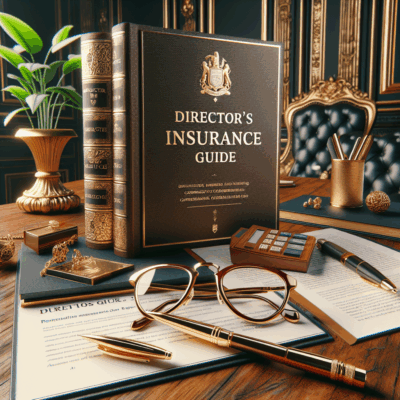Navigating the Complexities of Leadership: A Guide to the Best Directors Insurance
Serving on a board of directors is a position of immense privilege and responsibility. It signifies a culmination of experience, expertise, and trust. Directors are tasked with steering organizations toward prosperity, making critical strategic decisions, and upholding the highest standards of corporate governance. However, this leadership role is not without its perils. In today’s litigious business environment, directors are increasingly exposed to personal financial risk from a wide array of potential claims, including allegations of breach of duty, mismanagement, employment disputes, and regulatory violations. Even with the most diligent and ethical approach, the threat of legal action is a constant shadow. This is where the critical safeguard of directors and officers (D&O) insurance comes into play. But not all policies are created equal. Securing the best directors insurance is not merely a checkbox for corporate compliance; it is a fundamental component of robust risk management and a powerful tool for attracting and retaining top-tier talent.
This article will delve into the intricate world of D&O insurance, exploring what makes a policy truly exceptional. We will emphasize the non-negotiable importance of securing comprehensive directors insurance and the value of obtaining impartial advice (from anyone but just like us) to navigate this complex landscape. Our goal is to equip you with the knowledge needed to make an informed decision that protects both the individuals at the helm and the organization they serve.
Understanding the Core of Directors and Officers Insurance
At its essence, D&O insurance is a liability policy designed to protect the personal assets of a company’s directors, officers, and sometimes, its employees. It responds when these individuals are sued for alleged wrongful acts committed in their capacity as leaders of the organization. It is crucial to understand that corporate structures like limited liability companies (LLCs) or corporations generally protect personal assets from business debts, but they do not inherently shield individuals from personal liability for their own actions or decisions. A plaintiff can, and often will, sue both the company and the individuals on its board personally.
A standard D&O policy is typically structured in three parts, often referred to as “Sides”:
- Side A: This provides direct coverage to directors and officers when the company is legally unable to indemnify them. This is the most critical element of protection for the individual. Scenarios where this comes into play include bankruptcy (where corporate funds are frozen or unavailable) or when state law prohibits indemnification for certain acts.
- Side B: This reimburses the corporation for its costs when it does indemnify its directors and officers for a covered loss. This side protects the company’s balance sheet from the financial impact of defending its leadership.
- Side C: Also known as “entity coverage,” this extends protection to the organization itself for claims made against it, typically only for securities claims in publicly traded companies. For private companies, this coverage can often be broader.
The modern business landscape has seen a dramatic expansion in the types of threats that can trigger a D&O claim, moving far beyond shareholder lawsuits.
The Hallmarks of the Best Directors Insurance: Beyond the Basics
Identifying the best directors insurance requires moving beyond a simple price comparison. A cheap policy is often a hollow shield, riddled with exclusions and limitations that render it useless when needed most. True quality in a D&O policy is defined by its breadth, depth, and
clarity. Here are the key attributes to demand.
1. Comprehensiveness: The Bedrock of Protection
The term comprehensive directors insurance is not mere marketing fluff; it describes a policy with extensive and well-defined coverage. A comprehensive policy should explicitly address a wide spectrum of modern risks:
- Employment Practices Liability (EPL): Claims related to wrongful termination, discrimination, harassment, and retaliation are among the most common triggers for D&O claims. The best policies will seamlessly integrate or offer side-by-side robust EPL coverage.
- Cyber Liability and Data Breaches: Board members are increasingly held accountable for cyber oversight failures. A forward-thinking D&O policy will provide coverage for claims alleging a failure to implement adequate security measures or a poor response to a data breach.
- Regulatory and Investigations Coverage: Government and regulatory probes, from the SEC to the EPA and DOJ, are costly and complex. The best policies cover the costs of defending against formal investigations, even before any actual lawsuit is filed.
- Mergers & Acquisitions (M&A): Transactional liability is a high-risk area. Look for policies that provide automatic run-off coverage for selling directors and clarify coverage for acquisition targets.
- Full Prior Acts Coverage: This ensures that acts committed before the policy inception date are covered, provided they were not known and likely to give rise to a claim. A policy that excludes prior acts creates a dangerous gap.
- Broad Definition of “Claim” and “Wrongful Act”: The policy should define a “claim” to include not just lawsuits but also administrative proceedings, demands, and investigations. A “wrongful act” should be broadly defined to include errors, omissions, misstatements, neglect, and breaches of duty.
2. Impartial and Expert Advice: Your Strategic Compass
Perhaps the most critical step in securing the right coverage is seeking impartial advice. The D&O market is complex and nuanced. Relying solely on a broker who may have a limited portfolio of insurer partners or who is primarily motivated by commission can lead to suboptimal outcomes.
An impartial advisor or specialist broker acts as your fiduciary, meaning they are legally obligated to put your interests first. Their value is multi-faceted:
- Market Access: They have relationships with a wide range of A-rated domestic and international carriers, allowing them to truly shop the market on your behalf.
- Policy Dissection: They possess the expertise to dissect policy wordings, identify critical exclusions (e.g., Bodily Injury/Property Damage, Fraud, Personal Profit), and negotiate favorable terms. They can explain the stark difference between a “claims-made” and “occurrence” policy structure.
- Customization: They understand that a tech startup, a non-profit, a private manufacturing firm, and a public company have vastly different risk profiles. They tailor the placement to your specific industry, size, and stage of growth.
- Claims Advocacy: In the event of a claim, an experienced broker becomes an indispensable advocate, working with the insurer to ensure a smooth and fair claims process.
Securing impartial counsel ensures the policy you purchase is the right fit, not just the easiest sale for the agent.
3. Financial Strength of the Insurer
The best policy wording is worthless if the insurance company lacks the financial fortitude to pay a claim. Always insist on a carrier with a superior rating from agencies
like A.M. Best (e.g., A or A+), Standard & Poor’s, or Moody’s. This financial security provides peace of mind that the safety net will be there, even for a large, protracted legal battle.
4. Defense Costs and Retention Structures
A D&O claim is often a war of attrition fought with legal bills. The best policies feature:
- Duty to Defend vs. Reimbursement: A “duty to defend” policy means the insurer controls the defense and hires the lawyers. A “reimbursement” policy means you hire your own counsel and get paid back. The former can be more efficient, but the latter allows you to choose your own legal team. Understand which your policy provides.
- Advancement of Defense Costs: The policy should explicitly state that defense costs are advanced as they are incurred, not reimbursed at the end of the case. This is vital, as legal fees can mount into the millions quickly.
- Reasonably Structured Retention: The retention (similar to a deductible) is the amount the insured must pay before the policy responds. It should be structured fairly and be financially manageable for the organization.
The High Cost of Inadequate Coverage: A Cautionary Tale
The consequences of underinsurance or a poorly structured policy are severe. Without robust Side A coverage, directors can face financial ruin, forcing them to settle meritless claims because they cannot afford a defense. For the company, the inability to indemnify its directors makes it impossible to attract qualified leaders. Top talent will simply refuse to join a board that exposes them to unprotected personal risk.
A comprehensive directors insurance policy is not an expense; it is an investment in the stability and governance of the organization. It empowers directors to make bold, strategic decisions without the paralyzing fear of personal liability, fostering innovation and long-term growth.
The Procurement Process: A Step-by-Step Approach
- Engage an Impartial Specialist Broker: This is your first and most important step. Do not use a generalist.
- Conduct a Thorough Risk Assessment: Work with your broker to identify and articulate your organization’s unique exposures, from operational risks to industry-specific regulatory challenges.
- Market the Risk: Your broker will prepare a submission and present it to multiple insurers to solicit competitive quotes.
- Compare Proposals Meticulously: Scrutinize the coverage terms, conditions, exclusions, and financials. Do not default to the cheapest option.
- Negotiate Terms: Use your broker’s expertise to negotiate improved wording, broader coverage, or lower retentions.
- Implement and Educate: Once placed, ensure all directors and officers are briefed on the policy’s coverage and the process for reporting a potential claim.
Conclusion: An Indispensable Pillar of Modern Governance
In the final analysis, the pursuit of the best directors insurance is a strategic imperative. It is a complex purchase that demands diligence, expertise, and a focus on long-term security over short-term savings. By prioritizing comprehensive directors insurance that is tailored to the evolving threat landscape and by seeking out impartial professional guidance, organizations can build a resilient defense for their leaders.
This robust protection does more than just shield personal assets; it safeguards the very foundation of sound corporate governance. It ensures that those entrusted with steering an organization can do so with the confidence and clarity of mind required to navigate toward a successful future, secure in the knowledge that they are protected from the u
Frequently Asked Questions
Q: What is directors insurance?
A: Directors insurance, also known as Directors and Officers (D&O) liability insurance, is a policy that protects the personal assets of a company’s directors and officers if they are personally sued for alleged wrongful acts while managing the company.
Q: Why do I need directors insurance?
A: You need it to protect against personal financial loss from lawsuits. These can arise from a wide range of issues, including claims of mismanagement, breach of fiduciary duty, employment practice violations, or reporting errors, which are not covered by a standard commercial liability policy.
Q: What does the best directors insurance policy cover?
A: A top-tier policy typically covers legal defense costs, settlements, and judgments for claims against directors and officers. This includes coverage for alleged errors in judgment, negligence, misleading statements, and workplace torts like wrongful termination.
Q: How do I choose the best directors insurance for my company?
A: To choose the best policy, assess your company’s specific risks, compare coverage limits and exclusions from multiple insurers, understand the policy’s financial strength, and work with a broker who specializes in D&O insurance to navigate the complexities.





